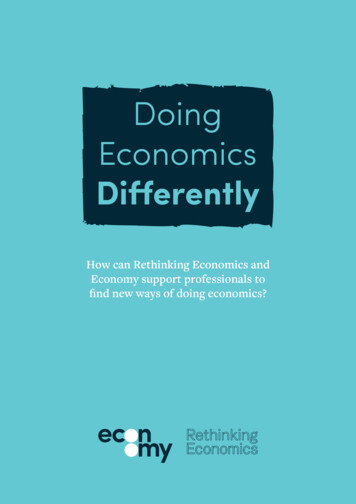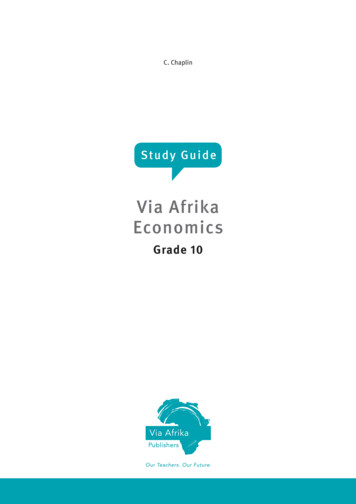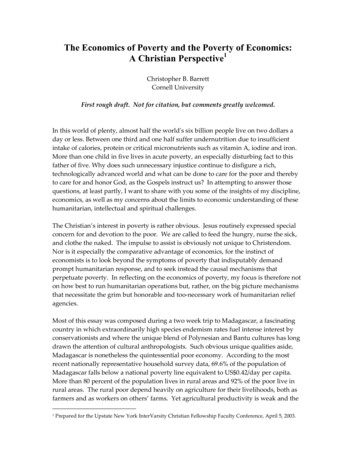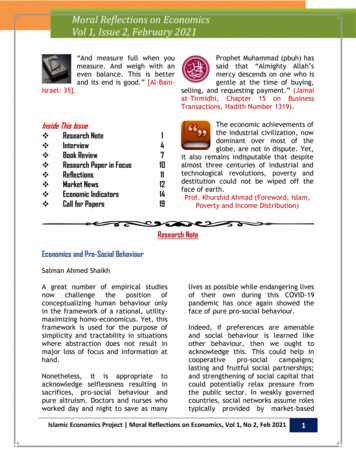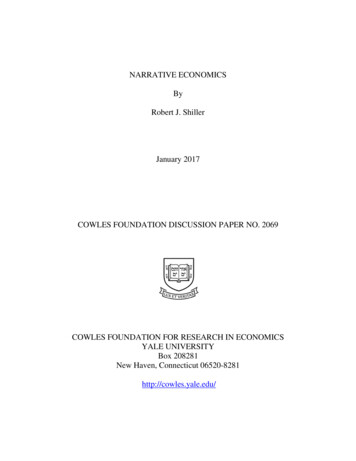
Transcription
NARRATIVE ECONOMICSByRobert J. ShillerJanuary 2017COWLES FOUNDATION DISCUSSION PAPER NO. 2069COWLES FOUNDATION FOR RESEARCH IN ECONOMICSYALE UNIVERSITYBox 208281New Haven, Connecticut 06520-8281http://cowles.yale.edu/
NARRATIVE ECONOMICSRobert J. ShillerJanuary, 2017Presidential address delivered at the 129th annual meeting of the American Economic Association, January7, 2017, Chicago, IL.The author declares no relevant conflicts of interest. The author thanks participants in seminars at whichearlier versions of this address were presented, at the Bank of England, at the Toulouse School ofEconomics/Toulouse Institute of Advanced Studies, and at the Yale University Department of Economics.Special thanks go to George Akerlof, Bruno Biais, Jean-François Bonnefon, Michael Bordo, Donald Cox,Peter Dougherty, William Goetzmann, Dasol Kim, Rachel Kranton, Terry Loebs, Ramsay MacMullen, PeterRousseau, Paul Seabright, Benjamin Shiller, Virginia Shiller, and Peter Temin. Research assistance wasprovided by Andrew Brod, Laurie Cameron Craighead and Nicholas Werle.1
Robert J. ShillerJanuary 2017JEL No. E00, E03, E30, G02, N1ABSTRACTThis address considers the epidemiology of narratives relevant to economic fluctuations. The human brainhas always been highly tuned towards narratives, whether factual or not, to justify ongoing actions, even suchbasic actions as spending and investing. Stories motivate and connect activities to deeply felt values and needs.Narratives “go viral” and spread far, even worldwide, with economic impact. The 1920-21 Depression, theGreat Depression of the 1930s, the so-called “Great Recession” of 2007-9 and the contentious politicaleconomic situation of today, are considered as the results of the popular narratives of their respective times.Though these narratives are deeply human phenomena that are difficult to study in a scientific manner,quantitative analysis may help us gain a better understanding of these epidemics in the future.Robert J. ShillerSterling Professor of Economics and Professor of FinanceCowles Foundation, Yale University30 Hillhouse AvenueNew Haven, CT 06511robert.shiller@yale.eduand NBER2
IntroductionBy narrative economics I mean the study of the spread and dynamics of popular narratives, thestories, particularly those of human interest and emotion, and how these change through time, tounderstand economic fluctuations. A recession, for example, is a time when many people have decided tospend less, to make do for now with that old furniture instead of buying new, or to postpone starting a newbusiness, to postpone hiring new help in an existing business, or to express support for fiscally conservativegovernment. They might make any of these decisions in reaction to the recession itself (that’s feedback), butto understand why a recession even started, we need more than a theory of feedback. We have to considerthe possibility that sometimes the dominant reason why a recession is severe is related to the prevalence andvividness of certain stories, not the purely economic feedback or multipliers that economists love to model.The field of economics should be expanded to include serious quantitative study of changingpopular narratives. To my knowledge, there has been no controlled experiment to prove the importance ofchanging narratives in causing economic fluctuations. We cannot easily prove that any association betweenchanging narratives and economic outcomes is not all reverse causality, from the outcomes to the narratives.But there have been true controlled experiments showing that people respond strongly to narratives, in thefields of marketing (Escalas 2007); journalism (Machill et al. 2007 ); education (McQuiggan et al. 2008);health interventions (Slater et al. 2003); and philanthropy (Weber et al. 2006).My goal in this paper is to describe what we know about narratives and the penchant of the humanmind to be engaged by them, to consider reasons to expect that narratives might well be thought of asimportant, largely exogenous shocks to the aggregate economy. This address extends some earlier work Ihave done with George Akerlof (Akerlof and Shiller, 2009, 2015) and some of my own earlier work goingback decades (Shiller 1984), but develops the analysis and captures a much broader relevant literature.Of course, almost nothing beyond spots on the sun is truly exogenous in economics, but newnarratives may be regarded often as causative innovations, since each narrative originates in the mind of a3
single individual (or a collaboration among a few). Joel Mokyr (2016) calls such an individual a “culturalentrepreneur,” and traces the concept back to David Hume (1742) who wrote that “what depends on a fewpersons is, in great measure, to be ascribed to chance, or secret and unknown causes; what arises from agreat number may often be accounted for by determinate and known causes.” 1I will present here some thoughts on these effects of a “few persons” and offer a class ofmathematical models for some of these determinate and known causes of the path of narratives, quantifyingthe dynamics of narratives, and will consider how our understanding can be enhanced of major economicevents: the Depression of 1920-21, the Great Depression of the 1930s, the Great Recession of 2007-2009,and our present time right after our narrative-filled 2016 presidential election.I use the term narrative to mean a simple story or easily expressed explanation of events that manypeople want to bring up in conversation or on news or social media because it can be used to stimulate theconcerns or emotions of others, and/or because it appears to advance self-interest. To be stimulating, itusually has some human interest either direct or implied. As I (and many others) use the term, a narrative isa gem for conversation, and may take the form of an extraordinary or heroic tale or even a joke. It is notgenerally a researched story, and may have glaring holes, as in “urban legends.” The form of the narrativevaries through time and across tellings, but maintains a core contagious element, in the forms that aresuccessful in spreading. Why an element is contagious, when it may even “go viral,” may be hard tounderstand, unless we reflect carefully on the reason people like to spread the narrative. Mutations innarratives spring up randomly, just as in organisms in evolutionary biology, and when they are contagious,the mutated narratives generate seemingly unpredictable changes in the economy.Narratives can be based on varying degrees of truth. Wishful thinking may enhance contagion(Benabou 2013). The impact of non-factual narratives might be somewhat greater in today’s world than indecades past, since established news media are in upheaval after the relatively recent advent of modern1Hume (1788) XIV p. 101.4
information technology and social media. But in past decades we can also observe that narratives with nofactual basis were widely disseminated and believed. For instance, until modern times, it was asserted thatwomen were not capable of learning men’s occupations (Goldin 2014). Similarly, it was argued that someracial or ethnic groups were not really capable of integrating into civilized society (Myrdal, 1974). Howpeople could believe these views in the past seems hard to imagine today because we are no longerimmersed in their narratives.Disturbingly, the Oxford Dictionary in 2016 gave “post-truth” as “international word of the year.” 2Are narratives becoming increasingly based on false ideas? This possibility is something we ought to try tounderstand better. Among normal people, narratives are often somewhat dishonest and manipulative. In acompetitive market where competitors manipulate customers and profit margins have been competed awayto normal levels, no one company can choose not to engage in similar manipulations. If they tried, theymight be forced into bankruptcy. A phishing equilibrium with a certain equilibrium acceptable level ofdishonesty in narrative is established (Akerlof and Shiller, 2015).The Role of Narratives Broadly, in the Social Sciences and the HumanitiesWhen we as economists want to understand the most significant economic events in our history,such as the Great Depression of the 1930’s, or subsequent recessions, or policies towards wealth andpoverty, we rarely focus on the important narratives that accompanied them. We have lagged behind otherdisciplines in attending to the importance of narratives (Figure 1), and while all disciplines use narrativesmore since 2010, economics (and finance) remain laggards. This is despite calls for economists’ attention to“social dynamics” and “popular models” (Shiller 1984); to a new “culturnomics” (Michele 2005); or“humanomics” (McCloskey 2016); or for more “narrativeness” in economics (Morson and Schapiro 2017).We see little use of enormous databases of written word that might be used to study -of-the-year/word-of-the-year-20165
Figure 1. JSTOR counts by field of articles containing the word “narrative” as a percent of all articles in the field, entiredatabase left and the years 2010-2016 only, right.Some would say that the field of history has always had an appreciation for narratives. However,historians need also to be reminded sometimes that a deep understanding of history requires imputing whatwas on the minds of those people who made history, what their narratives were, as historian RamsayMacMullen implored in his book, Feelings in History: Ancient and Modern (2003). He does not literallystress the concept of narratives: he has told me he would prefer a word conveying “stimulus to someemotional response, and there is no such word.” But he shows that if we try to understand people’s actions,we will need to replicate in ourselves as best we can the feelings they themselves experienced, and his bookdescribes many of the narratives that in history communicated such feelings.In the social sciences, the last half century saw the blossoming of schools of thought thatemphasized study of popular narratives, a study that has been variously named as narrative psychology(Bruner 1986); storytelling sociology (Berger and Quinney 2004); narrative approaches to religious studies6
(Ganzevoort 2013); narrative criminology (Presser and Sandberg 2015); and so on. The overriding theme isthat people typically have little or nothing to say if you ask them to explain their objectives or philosophy oflife, but they brighten up at the opportunity to tell personal stories, which then reveal much of their values(O’Conner 2000). For example, if one interviews in a prison, one finds that the subject tends to respondwell when asked to tell stories about other criminals, and these stories tend to convey a sense not ofamorality but of altered morality.Consideration of narratives in economics brings us to an unfamiliar association with literaturedepartments in our universities. Some literary theorists have found that certain basic structures of stories arerepeated constantly, though the names and circumstances change from story to story, perhaps suggestingthat the human brain practically has receptors for certain stories built in. Cawelti (1976) classifies what hecalls “formula stories.” Propp (1984) found 31 “functions” present in all folk stories. Tobias (1996) says thatin all of fiction there are only twenty master plots: “quest, adventure, pursuit, rescue, escape, revenge, theriddle, rivalry, underdog, temptation, metamorphosis, transformation, maturation, love, forbidden love,sacrifice, discovery, wretched excess, ascension and descension.” Booker (2004) argues that there are onlyseven basic plots: “overcoming the monster, rags to riches, voyage and return, comedy, tragedy, andrebirth.” According to literary theorist Mary Klages (2006), structuralism in literary theory takes such effortsto list all basic stories as “overly reductive and dehumanizing.” 3 Although dismissing these lists of basic plots,she asserts: “structuralists believe that the mechanisms which organize units and rules into meaningfulsystems come from the human mind itself.” 4 Peter Brooks (1992) says narratology should be concernedwith “how narratives work on us, as readers, to create models of understanding, and why we need and wantsuch shaping orders.”5 Well-structured narratives, Brooks argues, “animate the sense-making process” andfulfill a “passion for meaning” 6 and the study of narratives brings him to psychoanalysis.3456Klages p. 33Loc. Cit.Brooks (1992), location 74.Brooks, location 749.7
Narratives as Creative, Essentially Human, WorksPredicting the success of creative works with the public is an extremely difficult task, one that isfundamentally related to the challenge we have in predicting contagion rates of narratives. We don’tprecisely observe the mental and social processes that create contagion. For example, predicting the successof motion pictures before they are released is widely known to be quite difficult, (Litman 1983). JackValenti, former president of the Motion Picture Association of America, said:“With all the experience, with all the creative instincts of the wisest people in ourbusiness, no one, absolutely no one can tell you what a movie is going to do in themarketplace. . . Not until the film opens in a darkened theater and sparks fly up between thescreen and the audience can you say this film is right.” 7By analogy, the reason that writers pull quotes, especially paragraph-length quotes, and displaythem as I have just done is often to convey a narrative, to give the reader a historical sense of a past narrativethat had impact and might again have impact on the reader if it is repeated just as it was perfectly worded.As with jokes, a narrative has to be delivered just right to be effective. Similarly, with music we want to hearagain and again a performance that sounds exactly right and by the perfect performer. This is why narrativesare difficult to study, and why there are limitations in textual analysis involving word counts or n-gramcounts to quantify and study them.Since around the beginning of the twentieth century, scholars from a wide array of disciplines beganto think that narratives, stories that seem outwardly to be of entertainment value only, are really central tohuman thinking and motivation. For example, in 1938 the existentialist philosopher Jean-Paul Sartre wrote:“A man is always a teller of tales, he lives surrounded by his stories and the stories ofothers, he sees everything that happens to him through them; and he tries to live his life as ifhe were recounting it.”Jack Valenti, in a speech “Motion Pictures and Their Impact on Society in the Year 2001,” April 25, 1978, quoted inLitman (1983) p. 15978
The tales tend to have human interest, if only suggested. By analogy, when asleep at night, narrativesappear to us in the form of dreams. We do not dream of equations or geometric figures without somehuman element. Neuroscientists have described dreaming, which involves characters, settings, and ahierarchical event structure, as a story-telling instinct that resembles in brain activity a form ofspontaneous confabulation caused by lesions of the anterior limbic system and its subcorticalconnections (Pace-Schott, 2013).Anthropologists, who conduct research on the behavior of diverse tribes around the world, haveobserved a “universal” that people “use narrative to explain how things came to be and to tell stories”(Brown 1991). Visitors to any human society will observe people facing each other, sitting around thetelevision – or the campfire - together, and vocalizing, and more recently, tweeting, stories, at the sametime waiting to learn other’s reactions, interested in feedback that will either confirm or disconfirm one’sthoughts. It seems that the human mind strives to reach enduring understanding of events by formingthem into a narrative that is imbedded in social interactions.Some have suggested that it is stories that most distinguish us from animals, and even that ourspecies be called Homo narrans (Fisher 1984) or Homo narrator (Gould 1994) or Homo narrativus(Ferrand and Weil 2001) depending on whose Latin we use. Might this be a more accurate descriptionthan Homo sapiens, i.e., wise man? It is more flattering to think of ourselves as Homo sapiens, but notnecessarily more accurate.It is important to note that narratives may not generally be acted upon reflectively, since, in thewords of psychologists Schank and Abelson (1977), they may be taken as scripts. When in doubt as to howto behave in an ambiguous situation, people may think back to narratives and adopt a role as if acting in aplay they have seen before. The narratives have the ability to produce social norms that partially govern ouractivities, including our economic actions.9
Popular narratives may have a spirit of “us versus them,” a Manichean tone of revealed evildescribed of others in the story. Jokes are quite often at somebody else’s expense - members of some othergroup. In extreme cases, they may be focused on events as evidence of some kind of imagined conspiracy.Of course, it is rational for people to be alert to conspiracies, since history is filled with actualexamples of them. But the human mind seems to have a built-in interest in conspiracies, a tendency to forma personal identity and loyalty to friends built around perceived plots of others. This disposition appears tobe related to human patterns of reciprocity, of vengeance against presumed enemies, a tendency that hasbeen found relevant to economic behavior (Fehr and Gächter 2000). The disposition may be amplifiedindividually by brain damage, into a “paranoid personality disorder” that is recognized in the Diagnostic andStatistical Manual, Fifth Edition (DSM V) of the American Psychiatric Association as afflicting 2.3% to 4.4%of the U.S. adult population. 8There is a daunting amount in the scholarly literature about narratives, in a number of academicdepartments, and associated concepts of memetics, norms, social epidemics, contagion of ideas. Whilewe may never be able to explain why some narratives “go viral” and significantly influence thinking whileother narratives do not, we would be wise to add some analysis of what people are talking about if we areto search for the source of economic fluctuations. We economists should not just throw up our handsand decide to ignore this vast literature. We need to understand the narrative basis for macroeconomicfluctuations, and to think about how narrative economics ought to be more informing of policy actionsnow and in the future.Narratives are major vectors of rapid change in culture, in zeitgeist, and ultimately in economicbehavior. Spreading narratives, often many parallel narratives around a common theme, have been creatingThe American Psychiatric Association has discontinued in DSM V the term “paranoid schizophrenia” and otherterms describing paranoid forms of other psychotic disorders. Those who were once diagnosed paranoidschizophrenic might today have two diagnoses at once: paranoid personality disorder and schizophrenia.810
cultural change long before the Internet revolution, when the appearance of the parallel phenomenon ofcomputer viruses, which spread by contagion from computer to computer, popularized the virus metaphor.Talk of the epidemic spread of narratives goes back centuries. David Hume wrote in 1742:“. . . when any causes beget a particular inclination or passion, at a certain time and among acertain people, though many individuals may escape the contagion, and be ruled by passionspeculiar to themselves; yet the multitude will certainly be seized by the common affection, andbe governed by it in all their actions.” 9Charles McKay drew attention to the contagious spread of “extraordinary popular delusions”(1841). Gustave Le Bon said in his book Psychologie des foules (The Crowd): “Ideas, sentiments,emotions, and beliefs possess in crowds a contagious power as intense as that of microbes” (Le Bon 1895).Related terms were collective consciousness (Durkheim 1897), collective memory (Halbwachs 1920s),memes (Dawkins 1976). Contagion is also related to issues of identity, since an important part of mostnarratives describing past events involving people is that one must imagine oneself as another person, andthus momentarily at least feel a shared identity with someone else (Akerlof and Kranton 2011).Dimensions of Narratives Normal and AbnormalThe psychologist Jerome Bruner, who has stressed the importance of narratives, wrote that weshould not assume that human actions are ever driven in response to purely objective facts:“I do not believe that facts ever quite stare anybody in the face. From a psychologist’spoint of view, that is not how facts behave, as we well know from our studies of perception,memory, and thinking. Our factual worlds are more like cabinetry carefully carpentered thanlike a virgin forest inadvertently stumbled upon.” 10Narratives are human constructs that are mixtures of fact and emotion and human interest and otherextraneous detail that form an impression on the human mind.910Hume (1788) p. 103.Bruner (1998) p. 18.11
Psychiatrists and psychologists recognize that mental illness is often an extreme form of normalbehavior, or a narrow disruption of normal human mental faculties. So we can learn about the complexitiesof normal human narrative brain processing by looking at dysnarrativia, abnormal narrative phenomena.Neuroscientists Young and Saver (2001) listed some of its varied forms: arrested narration, undernarration,denarration, confabulation.Schizophrenia may be regarded as another brain anomaly related to narrative problems (Gaser etal. 2004). Schizophrenia has aspects of being a disorder of narrative, as it often involves the hearing ofimaginary voices delivering a fantastic, and disordered, narrative (Saavedra et al. 2009). Hearing voices as asymptom of schizophrenia is correlated with volume deficits in specific brain areas (Gaser et al. 2004). Thenarrative disruption found in autism spectrum disorder also is related to brain anomalies (Losh and Gordon2014), (Pierce et al. 2001).Narrative psychology is also related to the psychologists’ concept of framing (Kahneman andTversky 2000), Thaler (2015, 2016). If we can create an amusing story that will get retold, it can establish apoint of view, a reference point, which will have influence on decisions. It is also related to the Kahnemanand Tversky representativeness heuristic (1973), whereby people form their expectations based on similarityof circumstance to some idealized story or model, and tend to neglect base-rate probabilities.Psychologists have noted an affect heuristic, whereby people who are experiencing strongemotions, such as fear, tend to extend their feelings to unrelated happenings (Slovic et al. 2007). Sometimespeople note strong emotions or fears about possibilities that they know logically are not real, suggesting thatthe brain has multiple systems for assessing risk, and the “risk as feelings” hypothesis that some primitivebrain system more connected to palpable emotions has its own heuristic for assessing risk (Lowenstein et al.2001.)In joint work with William Goetzmann and Dasol Kim (2016), using data from a questionnairesurvey I have been conducting with institutional investors and high-income Americans since 1989, we found12
that these people generally have exaggerated assessments of the risk of a stock market crash, and that theseassessments are influenced by the news stories, especially front page stories, that they read. One intriguingfinding was that an event such as an earthquake could influence estimations of the likelihood of a stockmarket crash. The respondents in our survey gave statistically significantly higher probabilities to a stockmarket crash if there had been an earthquake within 30 miles of their zip code within 30 days, triggering theaffect heuristic. It seems reasonable to hypothesize that local earthquakes start local narratives with negativeemotional valence. Analogous evidence has been found of seemingly irrelevant events with narrativepotential having effects on economic or political outcomes: the effect of World Cup outcomes on economicconfidence (Dohmen et al. 2006,) and of background music in advertisements on viewers (Boltz et al.1991).The news media, for which the survival of any one organization is never assured in a competitivenews marketplace, must become adept at managing the news to make narratives work in their favor.Moreover, news media embellish the emphasized news with human interest stories. Given the large andoften dramatic degree of news media coverage of disasters – natural and man-made – and of crimes andhuman interest stories, it seems clear that news media believe that covering such events will result inincreased sales and attention for their news products. However, little attention has been given to the impactof such news stories on other stories in the same publication.Epidemic ModelsThe Kermack-McKendrick (1927) mathematical theory of disease epidemics marked a revolutionin medical thinking because it gave a realistic framework for understanding the all-important dynamics ofinfectious diseases. Their simplest model divided the population into three compartments: susceptibles,infectives, and recovereds, hence it is called an SIR Model or compartmental model. S is the number ofsusceptibles, people who have not had the disease and are vulnerable. I is the number of infectives, peoplewho have the disease and are actively spreading it. R is the number of recovereds, who have had the disease13
and gotten over it and are no longer capable of catching the disease again or spreading it. The totalpopulation N S I R is assumed constant.The key idea of the Kermack-McKendrick mathematical theory of disease epidemics was that in athoroughly mixing population the rate of increase of infectives in a disease epidemic is equal to a constantcontagion rate c 0 times the product of the number of susceptibles S and the number of infectives I minusa constant recovery rate r 0 times the number of infectives. Each time a susceptible meets an infective thereis a chance of infection. The number of such meetings per unit of time depends on the number ofsusceptible-infective pairs in the population. The recovery from the disease is assumed for simplicity tooccur in an exponential decay fashion, instead of the more usual notion of a relatively fixed timetable forthe course of the disease. The three-equation Kermack-McKendrick SIR model is:𝑑𝑑𝑑𝑑 ��𝑑 𝑐𝑐𝑐𝑐𝑐𝑐 𝑟𝑟𝑟𝑟𝑑𝑑𝑑𝑑𝑑𝑑𝑑𝑑 𝑟𝑟𝑟𝑟𝑑𝑑𝑑𝑑The same SIR model can of course be used to describe the word-of-mouth transmission of an idea.Here, the contagion rate is the fraction of the time that an encounter between an infective, a personinterested in and accepting of a story, effectively convinces the susceptible enough of the story to spread itfurther. Many encounters may be needed before a particular person is infected. The removal rate might bedescribed as the rate of forgetting, of simple decay of memories, but there is also cue-dependent forgetting.This removal also occurs as the repertory of other current stories evolves away from this story, so that thereare declining cues for the memory; this story seems less connected, less apt, or even superficially contrary tocurrent theories and prejudices. It might be plausible to suppose, as the model does, that contagion ratesand removal rates are both constant through time, if they are intrinsic to the narrative. Inaccurate retellings14
of the narrative that leave out its essential interest value, because of transmission error, just don’t survive, theparameter c refers to successful spread of the core interest value of a story.Even though direct face-to-face communications of ideas is less important in modern times becauseof the communications media, it still remains a workable model. The core model may apply no matter howpeople may connect with each other.This model implies that from a small number of initial infectives, the number infected andcontagious itself follows a bell-shaped curve, rising at first, then falling. A mutation in an old much-reduceddisease may produce a single individual who is infective, and then there will be a lag, possible a long lag if cis small, before the disease has infected enough people to be noticed in public. The epidemic will then riseto a peak, and then fall and come to an end without any change in the infection or removal rates, and beforeeveryone is infected.Figure 2. Solution to Kermack-McKendrick SIR model for N 100, I0 1 c .005, r .05.15
Figure 2 shows an example, implied by the above three equations, with N 100 people, very smalltransmission of infection per unit of time on any one exposure, I0 1 c .005, r .05. In this case, almost 100%of the population eventually gets infected. During an actual epidemic, public attention tends to focus on thenumber of infectives, seen here as a bell-shaped curve skewed to the right.Not everyone will ever catch the disease as some completely escape for lack of effective encounterwith an infective, and gradually it gets safer and safer for them because the infectives are becoming moreand more reduced in number as they get over the disease and are immune to it, so there are not enoughnew encounters to generate sufficient new infectives to keep the disease on the growth path. Eventually, theinfectives almost disappear, and the population consists almost entirely of susceptibles and recovereds.What creates a big disease that ultimately reaches a lot of people (the total ever infected andrecovered as measured by R )? It is a function of the ratio c/r of the two parameters. As time goes toinfinity, the number of people who have ever had the disease goes to a limit R (called the size of theepidemic) stric
The human brain has always been highly tuned towards narratives, whether factual or not, to justify ongoing actions, even such basic actions as spending and investing . Stories motivate and connect activities to deeply felt values and needs. . Well-structured narrativ



